
City Walking Trail
In the footsteps of legends...
Glasnevin cemetery may be located in one corner of the city, but the influence and impact of some the people buried here can be seen all over. We have created this trail so that you can make a day out of your visit to Glasnevin by taking in some of the city's sights while gaining an introduction to some of the figures you will learn about on the tours that are running here. We advise that this is a suggested route. The selected landmarks connected to some of the figures buried here are not exhaustive.
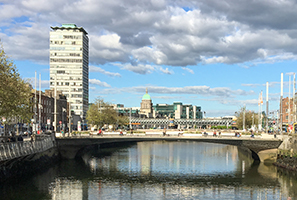
1. Rosie Hackett Bridge
You can begin your jaunt at the Rosie Hackett Bridge. The bridge was opened in 2014 and named in honour of Hackett who was a trade union leader, fought in the 1916 rising and co-founded the Irish Women's Workers Union with Delia Larkin who is also buried in Glasnevin Cemetery. Appropriately the bridge looks over to an iconic Dublin landmark, Liberty Hall, home to SIPTU (Services, Industrial, Professional, Technical Union). Hackett died in 1976. She is buried the St Paul's section of Glasnevin Cemetery.
Next... Walk along the river (not crossing over it) until you get to O'Connell Street.
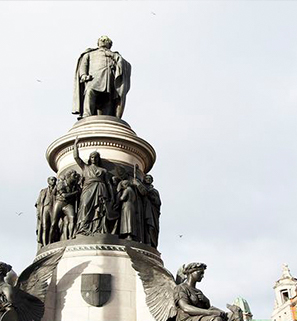
2. The O'Connell Statue
Heading over to the Northside, make your way to O'Connell Street which is one of the main shopping areas in Dublin. It is also teeming with historical significance. One of the first (of quite a few) monuments that your eyes will land on is the prominent O'Connell statue. Just like the street itself, it is dedicated to Daniel O'Connell aka The Liberator.
O'Connell is one of the most important figures in Irish history. He helped to found Glasnevin Cemetery so that 'people of all faiths' could be buried with dignity and respect. The tallest round tower in the country is another monument dedicated to O'Connell and he is buried in an ornate crypt beneath it. The crypt is part of the Irish History Tour at Glasnevin.
Next...There are a lot of landmarks straight up this street, bear in mind some of them are in the middle of the road.
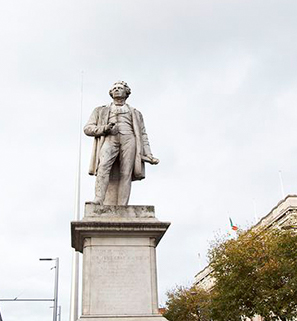
3. The Sir John Gray Statue
The next statue you will pass is that of Sir John Gray an Irish physician, surgeon, newspaper proprietor, journalist and politician. This statue was erected to recognise his contributions to the provision of a clean water supply to Dublin city and suburbs. Through his offices with Dublin Corporation, the Vartry Reservoir water supply works were completed and this project was significantly important in the improvement of living conditions and public health in Dublin city. The works improved sanitation and helped reduce outbreaks of cholera, typhus and other diseases associated with contaminated water.
Next...Keep heading north up O'Connell Street
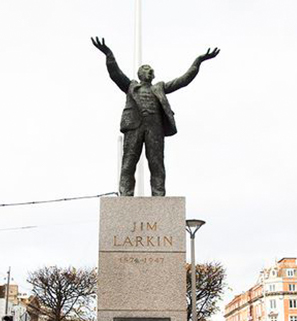
4. The Jim Larkin Statue
A short stretch up from O'Connell, you will find a simpler yet no less dramatic statue of a man made of bronze and arms outstretched. This is James Larkin or 'Big Jim' who Glasnevin cemetery is now home to. He founded the Irish Transport and General Worker's Union. He organised campaigns such as the Lock-Out of Dublin in 1913. His magnetic personality and gifted oratory attracted thousands to the union.
Another site of note around this part of O'Connell Street is the GPO which is still a working post office as well as a museum. Across the road, at the corner of North Earl Street is the James Joyce statue.
Next...to continue heading towards Glasnevin, keep walking straight up O'Connell street, at the junction you will see the statue of Charles Stewart Parnell.
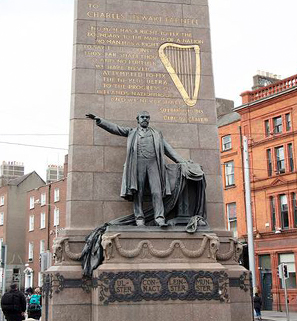
4. The Parnell Statue
Charles Stewart Parnell is buried in one of the most striking graves in Glasnevin cemetery. It is a mass grave with 11,000 victims of cholera, fulfilling Parnell's desire to be buried with the people. He was born into a Protestant land-owning family in 1846 and throughout his short but accomplished life, Parnell had two main objectives: achieving home rule and establishing land-owning rights for tenants.
Next...keep heading north towards Glasnevin, onto Parnell Square East.

6. The Garden of Remembrance
At the northern end of Parnell Square you will find the Garden of Remembrance, a formal garden installed in 1966 to mark the contribution of the many Irish men and women who died fighting for Irish freedom in 1916.
Next... Parnell Square East becomes Frederick Street North, you are still on the trail to Glasnevin.

7. Constance Markievicz Plaque
Still on North Frederick Street, but a little further up on the right hand side of the road, there is a plaque dedicated to Constance Markievicz who is buried in the Republican Plot at Glasnevin. She is a very important figure in the history of Irish independence. She was the first female to ever be elected to Westminster as an MP for Sinn Féin in 1918. As you can see from the plaque, she was also Minister for Labour in Ireland befitting of her dedication to rights for workers.
Next...take the next right, onto Dorset Street Lower

8. Peader Kearney Monument
Once on Dorset Street Lower, make sure you stay on the left side of the road here. You will see this monument to Peadar Kearney who is famous for writing The Soldier's Song or Amhráin na bhFhian as it is known in Irish. This composition is the Irish national anthem.
Next...two minutes further (north-west) will bring you to the Royal Canal. Cross the bridge and take an immediate left.
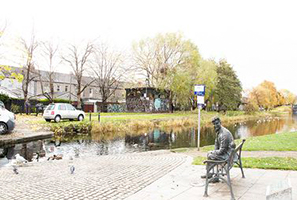
9. Brendan Behan Statue
Our final stop on the walk from Dublin city centre to Glasnevin cemetery before you actually hit the grounds is the statue of Brendan Behan by the Royal Canal. Behan also happens to be the nephew of Peadar Kearney. Born in 1923, Behan was involved with Republican activity and on one occasion shot at a policeman in Glasnevin cemetery. He was incarcerated for this and it was then that he began his writing career which was to make him famous throughout the world.
Fame never rested easy with him. Behan was a heavy drinker, remarking 'I only drink on two occasions - when I'm thirsty and when I'm not'. He died on March 20th 1964, aged 41.
Canal-side Stroll..
Stroll along the canal and take a right at the top of the road onto Finglas Road. Here you will come across Glasnevin cemetery, after passing landmarks througout the city dedicated to some of the most well-known people buried here.




